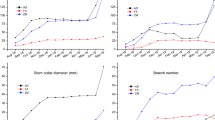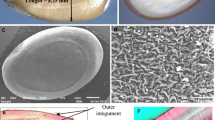Abstract
In situ edaphic factors affecting seed germination and seedling emergence of three framework species of Acacia were investigated with the intent of developing fundamental and scalable restoration capacity for Arabian dryland restoration. Direct seeding represents the most efficient means to restore vegetation at the landscape scale and this study provides insight into edaphic and ecological limitations, as well as effective protocols governing the use of native seeds for restoration in hyper-arid environments. The study was conducted in extant Acacia woodland habitat on conserved land (Thumamah Nature Park) in close proximity to Riyadh, Saudi Arabia. Broad-scale direct seeding using un- and pretreated Acacia gerrardii, A. tortilis, and A. ehrenbergiana seed, and two seed burial depths were implemented across three sites with distinct soil surface characteristics. Eight weeks post-sowing, random samples for each species × seed treatment × burial depth combination were excavated, sieved, and categorized as follows: failed to germinate, germinated but died prior to emerging, or successfully emerged. We show that germination and emergence of Acacia gerrardii, A. tortilis, and A. ehrenbergiana were driven by a three-way interaction among species, site, and seed burial depth. Treating seed with the signaling compound Moddus did not have a definitive effect, positive or negative, on any of the species investigated. Acacia gerrardii was the only species that exhibited widespread emergence, though emergence was not consistent across sites or burial depths. Germination was highest in disturbed soil (up to 69% for A. gerrardii), but very few (<2%) successfully emerged; a greater proportion of germinants in sandy soil emerged (up to 44% for A. gerrardii) even though the overall germination was less. Though species-dependent, a 2-cm sowing depth was most effective in sand; while in disturbed soil, sowing depths of 1 and 2 cm were comparable; and no germination was observed in gravelly clay soil. Sandy soil exhibited rapid water infiltration (107.6 mm min−1), and post-sowing surface crusting was a non-factor (0.44 kg cm−2). Disturbed soil exhibited moderate water infiltration (1.46 mm min−1) and post-sowing surface crusting was double that of sand (0.88 kg cm−2) and restrictive on seedling emergence. Gravelly clay exhibited extremely poor water infiltration (0.12 mm min−1), and surface crusting was severe (4.49 kg cm−2) and an order of magnitude greater than sand. The medium-coarse sand fraction, a key driver of the observed soil surface processes, was greatest in sand (55%) and significantly less and uniform in the disturbed (22%) and gravelly clay (22%) soils. Our findings demonstrate that soil surface characteristics and associated processes can dictate ecological processes at depths as shallow as 1–2 cm, and that soil crusts that slow water infiltration and impede seedling emergence rapidly reconstitute after disturbance; both are important considerations for restoring dryland vegetation.



Similar content being viewed by others
References
Abulfatih AH (1995) Seed germination in Acacia species and their relation to altitudinal gradient in south-western Saudi Arabia. J Arid Environ 31(2):171–178
ADA (Arriyadh Development Authority) 2003. http://ada.gov.sa/ADA_E/DocumentShow_e/?url=/res/ada/en/Projects/CSP/index.html. Accessed July 2016
ADA (Arriyadh Development Authority) 2015. http://www.ada.gov.sa/ADA_e/DocumentShow_e/?url=/res/ADA/En/Projects/Wadi_Hanifah/index.html. Accessed Feb 2016
Al-Rowaily SLR (1999) Rangeland of Saudi Arabia and the “tragedy of the commons”. Rangelands 21:27–29
Al-Saleh M (1997) Variability and frequency of daily rainfall in Riyadh, Saudi Arabia. Geogr Bul 39(1):48–57
Aref IM (2000) Effects of pre-germination treatments and sowing depths upon germination potential of some Acacia species. Research Bulletin 95, College of Agriculture, King Saud University, Riyadh, pp 5–17
Azam G, Grant CD, Nuberg IK et al (2012) Establishing woody perennials on hostile soils in arid and semi-arid regions—a review. Plant Soil 360:55–76
Barth HJ (1999) Desertification in the eastern province of Saudi Arabia. J Arid Environ 43:399–410
Baskin CC, Baskin JM (1998) Seeds: ecology, biogeography, and evolution of dormancy and germination. Academic Press, San Diego
Benigno SM, Dixon KW, Stevens JC (2013) Increasing soil water retention with native-sourced mulch improves seedling establishment in postmine Mediterranean sandy soils. Restor Ecol 21(5):617–626
Brady NC, Weil RR (2002) The nature and properties of soils, 14th edn. Prentice Hall, Upper Saddle River
Brown GF (1960) Geomorphology of Western and Central Saudi Arabia. In: Proceedings of 21st International Geolologic Congress, Copenhagen Report, vol 21. pp 150–159
Burrows GE, Virgona JM, Heady RD (2009) Effect of boiling water, seed coat structure and provenance on the germination of Acacia melanoxylon seeds. Aust J Bot 57:139–147
Caldwell TG, McDonald EV, Young MH (2009) The seedbed microclimate and active regeneration of disturbed lands in the Mojave Desert. J Arid Environ 73:563–573
Call CA, Roundy BA (1991) Perspectives and processes in revegetation of arid and semiarid rangelands. J Range Manage 44:543–549
Commander LE, Merritt DJ, Rokich DP et al (2009) Seed biology of Australian arid zone species: germination of 18 species used for rehabilitation. J Arid Environ 73:617–625
Critchley W, Siegert K (1991) Water harvesting. A manual for the design and construction of water harvesting schemes for plant production. Food and Agriculture Organisation of the United Nations, Rome
de Villalobos AE, Peláez DV (2001) Influences of temperature and water stress on germination and establishment of Prosopis caldenia Burk. J Arid Environ 49:321–328
Devit DA, Smith SD (2002) Root channel macropores enhance downward movement of water in a Mojave Desert Ecosystem. J Arid Environ 50:99–108
El-Sheikh MA, Thomas J, Alatar AA et al (2013) Vegetation of Thumamah Nature Park: a managed arid land site in Saudi Arabia. Rendiconti Lincei 24:349–367
Fehmi JS, Niu GY, Scott RL et al (2014) Evaluating the effect of rainfall variability on vegetation establishment in a semidesert grassland. Environ Monit Assess 186:395–406
Fei P, Tsuji W, Tao W et al (2012) Effects of sand burial and water regimes on seed germination and seedling emergence of two desert species. Adv Mater Res 356–360:2465–2472
Gardner A (2003) The new calculus of Bedouin pastoralism in the Kingdom of Saudi Arabia. Hum Organ 62:267–276
Gutterman Y (2001) Regeneration of plants in arid ecosystems resulting from patch disturbance. Kluwer Academic Publishers, Dordrecht
Hardegree SP, Moffet CA, Flerchinger GN et al (2013) Hydrothermal assessment of temporal variability in seedbed microclimate. Range Ecol Manage 66:127–135
Hussein MH, Awad MM, Abdul-Jabbar AS (2010) Effect of surface crust on rainfall infiltration in an aridisol in Northern Iraq. Eur Water 32:25–34
James JJ, Svejcar TJ, Rinella MJ (2011) Demographic processes limiting seedling recruitment in arid grassland restoration. J Appl Ecol 48:961–969
Krumbein WC (1934) Size frequency distribution of sediments. J Sediment Res 4:65–77
Lloret F, Casanovas C, Peñuelas J (1999) Seedling survival of Mediterranean shrubland species in relation to root:shoot ratio, seed size, and water and nitrogen use. Funct Ecol 13:210–216
Lundholm JT, Larson DW (2004) Experimental separation of resource quantity from temporal variability; seedling responses to water pulses. Oecologia 141:346–352
Maestre FT, Cortina J, Bautista S et al (2003) Small-scale environmental heterogeneity and spatiotemporal dynamics of seedling establishment in a semiarid degraded ecosystem. Ecosystems 6:630–643
Mehlich A (1984) Mehlich-3 soil test extractant; a modification of Mehlich-2 extractant. Commun Soil Sci Plant Anal 15(12):1409–1416
Monte-Recinas S, Márquez-Guzmán J, Orozco-Segovia A (2012) Temperature and water requirements for germination and effects of discontinuous hydration on germinated seed survival in Tillandsia recurvata L. Plant Ecol 213:1069–1079
Mubarak FA (2004) Urban growth boundary policy and residential suburbanization: Riyadh, Saudi Arabia. Habitat Int 28:567–591
Nathan R, Muller-Landau HC (2000) Spatial patterns of seed dispersal, their determinants and consequences for recruitment. Trends Ecol Evol 15:278–285
Nano CEM, Bowland AE, Pavey CR (2013) Factors controlling regeneration in a rare desert tree Acacia peuce: limits to soil seed bank accumulation in time and space. J Arid Environ 90:114–122
Noy-Meir I (1973) Desert ecosystems: environment and producers. Annu Rev Ecol Syst 4:25–51
Ogle K, Reynolds JF (2004) Plant responses to precipitation in desert ecosystems: integrating functional types, pulses, thresholds, and delays. Oecologia 141:282–294
Padilla FM, Pugnaire FM (2007) Rooting depth and soil moisture control Mediterranean woods seedling survival during drought. Funct Ecol 21(3):489–495
Ravi S, Breshears DD, Huxman TE et al (2010) Land degradation in drylands: interactions among hydrologic-aeolian erosion and vegetation dynamics. Geomorphology 116:236–245
Shaltout KH, El-Halawany EF, El-Kady HF (1996) Consequences of protection from grazing on diversity and abundance of the coastal lowland vegetation in Eastern Saudi Arabia. Biodivers Conserv 5:27–36
Stevens J, Senaratna T, Sivasithamparam K (2006) Salicylic acid induces salinity tolerance in tomato (Lycopersicon esculentum cv. Roma): associated changes in gas exchange, water relations and membrane stabilization. Plant Growth Regul 49:77–83
Syngenta 2013, Syngenta, crops and innovation, research and development. http://www.syngenta.com. Accessed Nov 2013
Wagner M, Pywell RF, Knopp T et al (2011) The germination niches of grassland species targeted for restoration: effects of seed pre-treatments. Seed Sci Res 21:117–131
Walck JL, Hidayati S, Dixon KW et al (2011) Climate change and plant regeneration from seed. Glob Change Biol 17:2145–2161
Walkley A, Black IA (1934) An examination of Degtjareffmethod for determining soil organic matter and a proposed modification of the chromic acid titration method. Soil Sci 37:29–37
Ward D, Rohner C (1997) Anthropogenic causes of high mortality and low recruitment in three Acacia tree taxa in the Negev Desert, Israel. Biodivers Conserv 6(6):877–893
Watson IW, Westoby M, Holm AM (1997) Continuous and episodic components of demographic change in arid shrubs: models of two Eremophila species from Western Australia compared with published data on other species. J Ecol 85:833–846
Wiegand K, Jeltsch F, Ward D (2004) Minimum recruitment frequency in plants with episodic recruitment. Oecologia 141:363–372
Yang HL, Huang ZY, Ye YZ et al (2010) Effects of soil moisture profile on seedling establishment in the psammophyte Hedysarum leave in the semiarid Otindag Sandland, China. J Arid Environ 74:350–354
Zheng YR, Xie ZX, Yu Y et al (2005) Effects of burial in sand and water supply regime on seedling emergence of six species. Ann Bot 95(7):1237–1245
Acknowledgements
The authors acknowledge the support of the government of the Kingdom of Saudi Arabia, and in particular the partner organization Arriyadh Development Authority for funding the work and providing permission to conduct this research in Thumamah Nature Park. Dr. Lucy Commander and David Symons of Kings Park and Botanic Garden provided assistance with seed viability analysis undertaken at the Department of Agriculture and Food, Western Australia.
Author information
Authors and Affiliations
Corresponding author
Additional information
Communicated by Dr. Olga Kildisheva, Dr. Lauren Svejcar and Dr. Erik Hamerlynck.
Rights and permissions
About this article
Cite this article
Mayence, C.E., Stevens, J.C., Courtney, P. et al. Edaphic constraints on seed germination and emergence of three Acacia species for dryland restoration in Saudi Arabia. Plant Ecol 218, 55–66 (2017). https://doi.org/10.1007/s11258-016-0680-z
Received:
Accepted:
Published:
Issue Date:
DOI: https://doi.org/10.1007/s11258-016-0680-z




